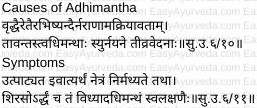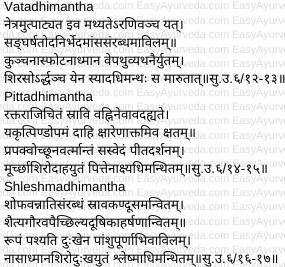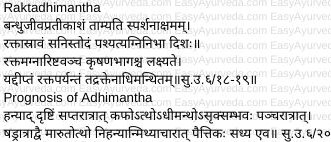Adhimantha – Meaning, Causes, Types, Symptoms, Treatment
By Dr Raghuram Y.S. MD (Ay) & Dr Manasa, B.A.M.S
Adhimantha is an eye disorder. It is included in Sarvagata Netra Roga i.e. diseases afflicting all parts of the eye. This means to tell that when these set of diseases occur, they afflict all the parts of the eye instead of appearing in particular parts of the eye.
Read – Eye Diseases Causes, Pathogenesis, Symptoms, Treatment, Herbs
Table of Contents
Causes, Pathogenesis
People suffering from Abhishyanda i.e. conjunctivitis, consumption of incompatible foods and indulgence in unwholesome life activities lead to worsening of conjunctivitis. This will lead to 4 types of adhimantha which are very painful.
Causes – Abhisyanda is the cause of all eye disorders, including Adhimantha. When conjunctivitis is not treated or when person suffering from conjunctivitis is exposed to etiological factors adhimantha is manifested.
The common causative factors mentioned for manifestation of all eye disorders are also applicable for causation of adhimantha.
Symptoms
- Utpatyata iva – feeling of someone trying to pull out the eyes
- Atyartham netram nirmathyate – feeling as if someone is churning one’s eyes
- Shiraso ardham – pain in half portion of head
The symptoms caused due to involved doshas will form different symptom complexes in the sub-types of the disease.
Read – Ayurvedic Eye Health Tips, Diet, Yoga
Types and Symptoms
Types of adhimantha are said to be as many as abhisyanda. There are 4 types.
Vatadhimantha
- As if the eye is being forcibly removed / pulled out from within
- Severe pain as if the eye is being churned with piece of wood for churning fire
- Feel as if the eye is being scrubbed
- As if the eye is being pierced with needle
- Pain as if the eye is torn with a sharp instrument
- Loss of muscles in the eye (ocular muscles)
- Eye looks dirty / dirt appears spread over the eyes
- Constriction of the eyes
- Feeling as if the eyes are getting burst open
- Increased tension in the eyes (explains increased intraocular pressure i.e. IOP, hallmark of glaucoma)
- Tremors in the eyes
- Severe headache in half part of the head
Master Vagbhata adds tinnitus, giddiness and severe pain in the forehead, eyes and eyebrows in the list of symptoms.
Pittadhimantha
- Red colored lines manifest in the entire eye
- Discharges from the eye
- Burning sensation as if the eyes are burnt with fire
- Eyes are dark coppery in color resembling piece of liver
- Burning pain similar to wounds caused by alkali
- Suppuration and swelling in the margins of the eyelids
- Excessive sweating
- Every material appears yellow
- Loss of consciousness intermittently
- Burning sensation in the head
Read – Ayurveda Eye Treatment Types, Methods – Ashtanga Hrudaya Sutrasthana 23
Shleshmadhimantha
- There is absence of burning sensation, redness or pain as in inflammation of eyes but discharges, itching, coldness, heaviness, stickiness, collection of dirt in the eyes and horripulation are present
- Objects are seen as if they are covered with dust and are unclearly seen
- Dirtiness of the eyes
- Blockage in the nose
- Headache
Raktadhimantha
- Eye becomes red resembling the flowers of Japa i.e. hibiscus
- Feel of darkness in front of the eyes
- Tenderness of the eyes
- Bleeding or red colored discharges from the eye
- Throbbing pain in the eyes
- Everything around seems to be burning in fire
- The black of the eye looks like soap nut immersed in blood
- Eye appears as if burning in fire and there is redness around the eyes
Read – Watery Eyes: Causes, Ayurvedic Treatment, Remedies
Sanskrit Verses



Prognosis
With consumption of incompatible foods and getting indulged in unwholesome activities or when not treated properly there is loss of vision in –
- 7 days in kaphadhimantha
- 5 days in raktadhimantha
- 6 days in vatadhimantha
- Immediately in pittadhimantha
Treatment
All four types of Adhimantha are classified under vyadhana sadhya rogas i.e. diseases which are curable by bloodletting, especially venesection type of bloodletting.
Since the adhimanthas are formed from their respective abhisyandas, the treatments of related abhisyandas are applicable to the subtypes of adhimantha. This means to tell that –
- Vatadhimantha is treated on the lines of Vatabhisyanda treatment
- Pittadhimantha is treated on the lines of Pittabhisyanda treatment
- Shleshmadhimantha is treated on the lines of Shleshmabhisyanda treatment
- Raktadhimantha is treated on the lines of Raktabhisyanda treatment
Click to Consult Dr Raghuram Y.S. MD (Ayu) – Skype









